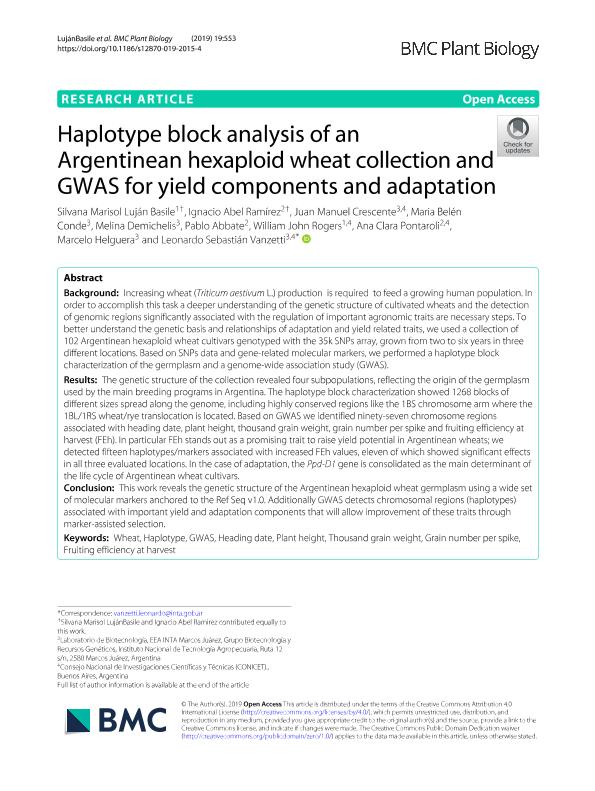Artículo
Haplotype block analysis of an Argentinean hexaploid wheat collection and GWAS for yield components and adaptation
Basile, Silvana Marisol Lujan ; Ramírez, Ignacio Abel; Crescente, Juan Manuel
; Ramírez, Ignacio Abel; Crescente, Juan Manuel ; Conde, Maria Belén; Demichelis, Melina; Abbate, Pablo; Rogers, William John
; Conde, Maria Belén; Demichelis, Melina; Abbate, Pablo; Rogers, William John ; Pontaroli, Ana Clara; Helguera, Marcelo; Vanzetti, Leonardo Sebastián
; Pontaroli, Ana Clara; Helguera, Marcelo; Vanzetti, Leonardo Sebastián
 ; Ramírez, Ignacio Abel; Crescente, Juan Manuel
; Ramírez, Ignacio Abel; Crescente, Juan Manuel ; Conde, Maria Belén; Demichelis, Melina; Abbate, Pablo; Rogers, William John
; Conde, Maria Belén; Demichelis, Melina; Abbate, Pablo; Rogers, William John ; Pontaroli, Ana Clara; Helguera, Marcelo; Vanzetti, Leonardo Sebastián
; Pontaroli, Ana Clara; Helguera, Marcelo; Vanzetti, Leonardo Sebastián
Fecha de publicación:
12/2019
Editorial:
BioMed Central
Revista:
BMC Plant Biology
ISSN:
1471-2229
Idioma:
Inglés
Tipo de recurso:
Artículo publicado
Clasificación temática:
Resumen
Background: Increasing wheat (Triticum aestivum L.) production is required to feed a growing human population. In order to accomplish this task a deeper understanding of the genetic structure of cultivated wheats and the detection of genomic regions significantly associated with the regulation of important agronomic traits are necessary steps. To better understand the genetic basis and relationships of adaptation and yield related traits, we used a collection of 102 Argentinean hexaploid wheat cultivars genotyped with the 35k SNPs array, grown from two to six years in three different locations. Based on SNPs data and gene-related molecular markers, we performed a haplotype block characterization of the germplasm and a genome-wide association study (GWAS). Results: The genetic structure of the collection revealed four subpopulations, reflecting the origin of the germplasm used by the main breeding programs in Argentina. The haplotype block characterization showed 1268 blocks of different sizes spread along the genome, including highly conserved regions like the 1BS chromosome arm where the 1BL/1RS wheat/rye translocation is located. Based on GWAS we identified ninety-seven chromosome regions associated with heading date, plant height, thousand grain weight, grain number per spike and fruiting efficiency at harvest (FEh). In particular FEh stands out as a promising trait to raise yield potential in Argentinean wheats; we detected fifteen haplotypes/markers associated with increased FEh values, eleven of which showed significant effects in all three evaluated locations. In the case of adaptation, the Ppd-D1 gene is consolidated as the main determinant of the life cycle of Argentinean wheat cultivars. Conclusion: This work reveals the genetic structure of the Argentinean hexaploid wheat germplasm using a wide set of molecular markers anchored to the Ref Seq v1.0. Additionally GWAS detects chromosomal regions (haplotypes) associated with important yield and adaptation components that will allow improvement of these traits through marker-assisted selection.
Archivos asociados
Licencia
Identificadores
Colecciones
Articulos(INBIOTEC)
Articulos de INSTITUTO DE INV. EN BIODIVERSIDAD Y BIOTECNOLOGIA
Articulos de INSTITUTO DE INV. EN BIODIVERSIDAD Y BIOTECNOLOGIA
Articulos(SEDE CENTRAL)
Articulos de SEDE CENTRAL
Articulos de SEDE CENTRAL
Citación
Basile, Silvana Marisol Lujan; Ramírez, Ignacio Abel; Crescente, Juan Manuel; Conde, Maria Belén; Demichelis, Melina; et al.; Haplotype block analysis of an Argentinean hexaploid wheat collection and GWAS for yield components and adaptation; BioMed Central; BMC Plant Biology; 19; 1; 12-2019; 1-16
Compartir
Altmétricas



